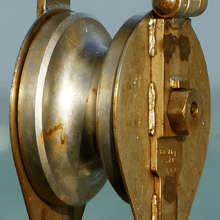Sheave
A sheave (/ʃiːv/) or pulley wheel is a grooved wheel often used for holding a belt, wire rope, or rope and incorporated into a pulley. The sheave spins on an axle or bearing inside the frame of the pulley. This allows the wire or rope to move freely, minimizing friction and wear on the cable. Sheaves can be used to redirect a cable or rope, lift loads, and transmit power. The words sheave and pulley are sometimes used interchangeably.
| Look up sheave in Wiktionary, the free dictionary. |

Adjustable pulley
A sheave can also refer to a pulley which has an adjustable operating diameter for use with a mechanical belt. This is accomplished by constructing the pulley out of several pieces. The two main "halves" of the pulley can be moved closer together or farther apart, thus altering the operational diameter. The usual construction is some sort of locking collar or set screws to secure the components, one half with a threaded central shaft and one half with a threaded center. By rotating the components one can "screw" the parts closer together or further apart, thus changing the distance between the two halves and allowing the belt to ride higher or lower in the groove. The adjustments are constrained to a specific range of size and are not limitless. One application of this is the Variomatic automatic transmission.
See also
- Block and tackle – system of two or more pulleys and a rope or cable
- Block (sailing) – Sailing term; single or multiple pulley
- Eccentric (mechanism) – Circular disk rigidly fixed to a rotating axle with its centre offset from that of the axle
- Slickline – A single strand wire which is used to run tools into wellbore
- Wireline (cabling) – Wireline technology used by operators of oil and gas wells